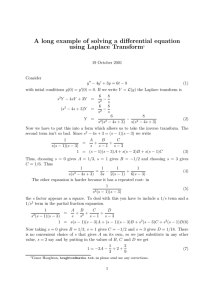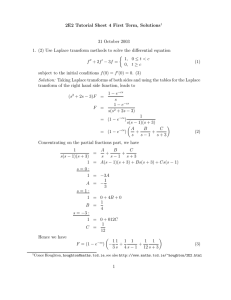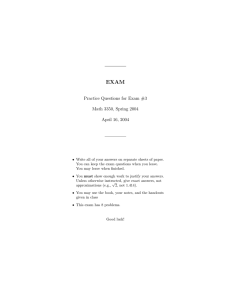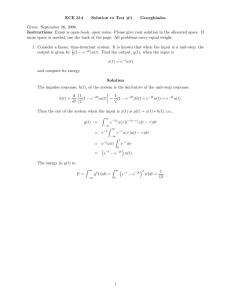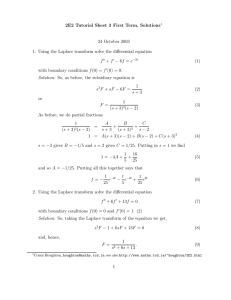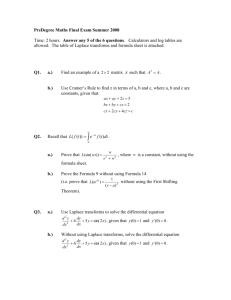2E2 Tutorial Sheet 2 First Term, Solutions 17 October 2003
advertisement
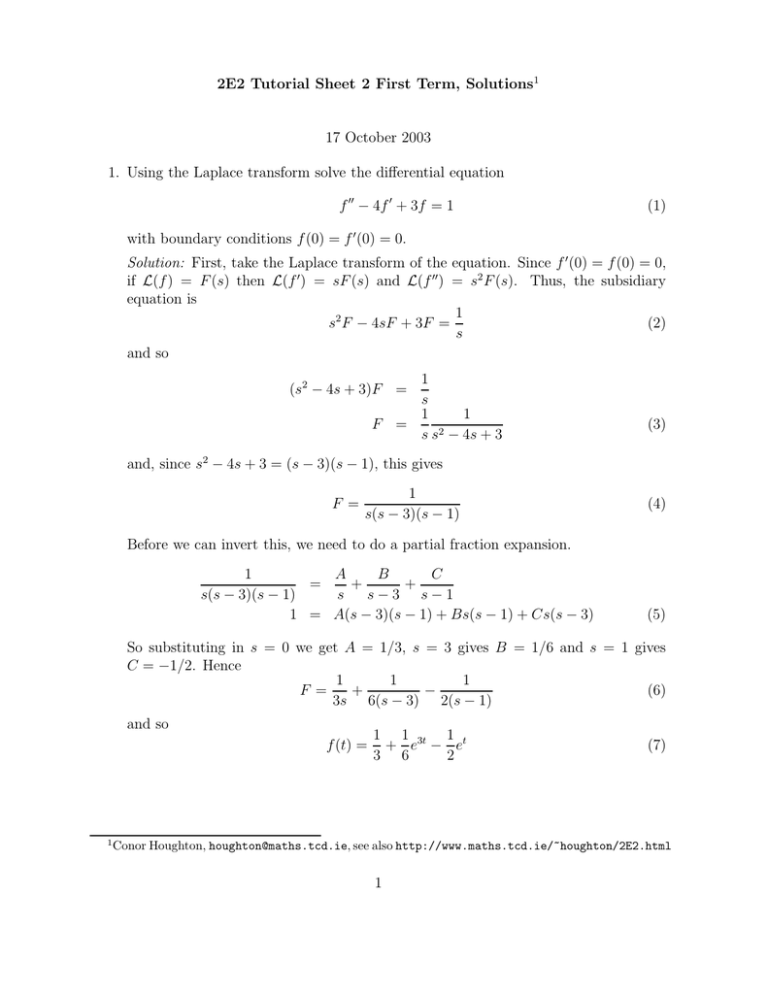
2E2 Tutorial Sheet 2 First Term, Solutions1 17 October 2003 1. Using the Laplace transform solve the differential equation f 00 − 4f 0 + 3f = 1 (1) with boundary conditions f (0) = f 0 (0) = 0. Solution: First, take the Laplace transform of the equation. Since f 0 (0) = f (0) = 0, if L(f ) = F (s) then L(f 0 ) = sF (s) and L(f 00 ) = s2 F (s). Thus, the subsidiary equation is 1 s2 F − 4sF + 3F = (2) s and so 1 s 1 1 F = 2 s s − 4s + 3 (s2 − 4s + 3)F = (3) and, since s2 − 4s + 3 = (s − 3)(s − 1), this gives F = 1 s(s − 3)(s − 1) (4) Before we can invert this, we need to do a partial fraction expansion. A B C 1 = + + s(s − 3)(s − 1) s s−3 s−1 1 = A(s − 3)(s − 1) + Bs(s − 1) + Cs(s − 3) (5) So substituting in s = 0 we get A = 1/3, s = 3 gives B = 1/6 and s = 1 gives C = −1/2. Hence 1 1 1 + − (6) F = 3s 6(s − 3) 2(s − 1) and so f (t) = 1 1 1 3t 1 t + e − e 3 6 2 (7) Conor Houghton, houghton@maths.tcd.ie, see also http://www.maths.tcd.ie/~houghton/2E2.html 1 2. Using the Laplace transform solve the differential equation f 00 − 4f 0 + 3f = 2et (8) with boundary conditions f (0) = f 0 (0) = 0. Solution: This time we have L(2et ) = 2/(s − 1) on the right hand side. This means that the subsidiary equation is (s2 − 4s + 3)F = 2 s−1 (9) so 2 (10) (s − 1)2 (s − 3) We need to do partial fractions again, but this is one of those cases with a repeated root: A B C 1 = + + (11) 2 2 (s − 1) (s − 3) s − 1 (s − 1) s−3 and multiplying across F = 1 = A(s − 1)(s − 3) + B(s − 3) + C(s − 1)2 (12) so s = 1 gives B = −1/2 and s = 3 gives C = 1/4. No value of s gives A on its own, so wee try s = 2: 1 1 (13) 1 = −A + + 2 4 which means that A = −1/4. Hence F =− and 1 1 1 − + 2(s − 1) (s − 1)2 2(s − 3) 1 1 f = − et − tet + e3t 2 2 (14) (15) 3. Using the Laplace transform solve the differential equation f 00 − 4f 0 + 3f = 0 (16) with boundary conditions f (0) = 1 and f 0 (0) = 1. Solution: In this example there are non-zero boundary conditions. Since L(f 0 ) = sF − f (0) L(f 00 ) = s2 F − sf (0) − f 0 (0) (17) (18) the subsidiary equation in this case is s2 F − s − 1 − 4sF + 4 + 3F = 0 2 (19) so (s2 − 4s + 3)F = s − 3. Hence (20) 1 s−1 (21) f (t) = et (22) F = and 4. Using the Laplace transform solve the differential equation y 00 − 2ay 0 + a2 y = 0 (23) with boundary conditions y 0 (0) = 1 and y(0) = 0. a is some real constant. Solution: Taking the Laplace transform we get s2 Y − 1 − 2aY + a2 Y = 0 and hence Y = 1 (s − a)2 (24) (25) which means that y = teat 3 (26)

